FW
BGMEA has decided that its members can consider shutting factories to avoid the spread of the COVID-19. However, if a factory management decides to run the factory it will have to follow the highest hygiene and safety measures such that the workers are safe, Garment shipments account for more than 80 per cent of the national exports of Bangladesh and the sector employs more than 40 lakh workers.
The prime minister has given specific directives and called for taking some measures to ensure protection and good health.
Over the last 30 years, Bangladesh has grown into a sweater hub as many entrepreneurs invested heavily Bangladesh is a major supplier of sweater products to the world and exports approximately $3.5 billion worth of items annually.
The Union cabinet has approved the continuation of Rebate of State and Central Taxes and Levies (RoSCTL) for export of garments and made-ups from April 1, 2020, till the scheme is merged with Remission of Duties and Taxes on Exported Products (RoDTEP). According to AEPC, this will help exporters in promoting shipments.
AEPC chairman A Sakthivel says, given the acute shortage of working capital, this reimbursement should be given as Direct Cash Transfer, as in the case of erstwhile ROSL and drawback. This will reduce the time and transaction cost of availing the scheme.
Apparel exporters, who were anyway facing trouble with the reversal of policy benefits like MEIS and delays in refunds, are now facing uncertainties related to both export orders and import of raw materials. Hence, the continuation of this benefit will strengthen the entire cotton textiles value chain.
Chinese officials are weighing potential responses to a series of mixed signals emerging from the US, where officials have been touting progress in the phase one trade agreement, while at the same time reinstating tariffs on Chinese products. China remains committed to implementing the phase one deal, despite the Coronavirus epidemic that has seriously affected economic activities both in China and abroad, but the US should also focus on easing tensions with China and not raising them.
Even as China's trade dropped significantly in the first two months of the year, its soybean imports from the US jumped six fold year-on-year to 6.101 million tons, reports o Reuters. Also, Chinese companies have resumed importing US liquefied petroleum gas after Chinese officials exempted it from tariffs, The US will collect a 25 per cent tariff on certain Chinese products after a previous exemption expired and the US Trade Representative's (USTR) office did not extend the exemption on those goods, according to a recent notice from the USTR. The USTR would extend tariff exemptions for 11 categories of products - part of $34 billion worth of Chinese goods targeted by a 25 percent US tariff imposed in July 2018 - for another year, but left out 22 categories of products, including breast pumps and water filters. In addition, the US decided to slap anti-dumping and anti-subsidy duties on up to 262.2 percent and 293.5 percent, respectively, on Chinese wood cabinets and vanities imports.
The All Pakistan Textile Mills Association and the Pakistan Ready Made Garments Manufacture and Exporters Association has appealed to government to fix interest rate at 5 per cent for the industry, especially when it is facing problems due to deferment or cancellation of shipments to Europe and the USA on account of closure of international borders due to COVID-19.
Earlier, the State Bank of Pakistan cut its benchmark interest rate for the second time in a week, lowering it by 150 basis points to 11 percent. Similarly, chief coordinator PRGMEA Ijaz Khokhar too has said the government should lock down the interest rate at 5 per cent for industry, especially for the small and medium enterprises for at least one year. He also said that the SME is the sector which is mostly affected by the coronavirus. He said most export orders given to small and medium enterprises were either halted or cancelled so the government should announce relief package for this industry as thousands of people were directly or indirectly associated with this sector.
Khokar also appealed to government to grant permission for entry of export goods worth millions of dollars dispatched from Sialkot to Karachi. The cargo was stuck on the border of Sindh as the Sindh government was not allowing the cargo to enter its province. Similarly, shipments of worth millions of dollars were ready for dispatching and were laying in factories of Sialkot waiting for government's policy regarding movement of export goods.
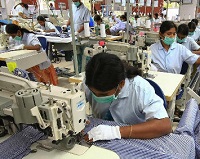 CANCEL the shipments, is not the right word at the moment, perhaps to HOLD could be more reasonable.
CANCEL the shipments, is not the right word at the moment, perhaps to HOLD could be more reasonable.
Brands should stand by their commitments as their orders are already in process. This is the only way partnerships work
The least could be expected from brands and retailers is to come at discussion table , the moment world comes out of lock down. Brands should talk to their suppliers and workout a workable solution, to be executed over a period of time.
One of the worst international emergencies experienced by humanity in modern history, the Coronavirus pandemic is likely to have a catastrophic effect on the entire world “The economic impact will be too mind boggling” says Rajesh Bheda, Managing Director, Rajesh Bheda Consulting. “The garment industry is likely to be one of the worst sufferers as most global fashion giants have downed shutters in major consumption markets of the US and Europe. Many have suspended deliveries of the ready goods waiting at ports and in factories across the globe, majority of them situated in Asia,” he adds.
Millions of workers in supply countries to be affected
This will have a devastating effect on millions of garment workers and businesses that work on thin margins. As BGMEA estimates, till March 25, shipments worth 2.58 billion have already been cancelled or suspended, involving 936 factories and 1.92 million workers. In India, the factories in Tirupur have been shut from March 22 onwards. Across the country, factories have shut with the national lock down from March 25.
shipments worth 2.58 billion have already been cancelled or suspended, involving 936 factories and 1.92 million workers. In India, the factories in Tirupur have been shut from March 22 onwards. Across the country, factories have shut with the national lock down from March 25.
“This behaviour on part of brands is totally unconscionable,” opines Sarah Krasley CEO, Shimmy Technologies. “millions of factory workers are in serious jeopardy as brands have not paid their suppliers for work already done. It is deeply saddening how quickly they have turned their backs on the very partners who are critical to their success,” she adds.
Appeal to retain orders
Meanwhile, India’s textile minister Smriti Irani has appealed to factory owners not to cancel shipments. On behalf of the seven million craft persons spread across craft clusters in India and 20,000 exporters who are part of the Export Promotion Council for Handicrafts (EPCH) and Carpet Export Promotion Council (CEPC), Irani assured brands that both EPCH and CEPC will be working with them to ensure that possible measures are taken to stimulate growth in future.
BGMEA president Dr Rubana Huq has also appealed to buyers not to abandon. With the fate of our industry and workers being uncertain, it’s time to act in compassionate manner,” she said adding, “ However, with brands cancelling orders and deferring shipments, we have no idea what tomorrow holds.”
Brands should act like big brother
“In terms like these brands should act like a Big Brother,” feels Mayank Jain, Mayank, Founder, Moon Technovision. “They should stand by their commitments as their orders are already in process. This is the only way partnerships work,” he emphasises. It’s time for big brands/retailers of the world to protect the industry for a greater interest of the industry. Brands can hold their orders instead of cancelling them or accept procurement liability in case cancellation is unavoidable due to fashion/season change.
 Amid the global gloom of COVID-19 pandemic, the Shanghai Fashion Week (SHFW) is engaging hundreds of thousands of viewers through live streaming. One of the world's top runways, SHFW opened on Tuesday as planned after its counterparts in Europe were hit by the COVID-19 outbreak. The organisers took the bold step of moving the fashion calendar online in cooperation with China's e-tailing juggernaut Alibaba Group's Taobao and Tmall – the biggest marketplace for live streaming business – making it world's first entirely live streamed digital fashion week.
Amid the global gloom of COVID-19 pandemic, the Shanghai Fashion Week (SHFW) is engaging hundreds of thousands of viewers through live streaming. One of the world's top runways, SHFW opened on Tuesday as planned after its counterparts in Europe were hit by the COVID-19 outbreak. The organisers took the bold step of moving the fashion calendar online in cooperation with China's e-tailing juggernaut Alibaba Group's Taobao and Tmall – the biggest marketplace for live streaming business – making it world's first entirely live streamed digital fashion week.
Features autumn/winter collections
The mega show on from March 24 to 30, 2020 features over 100 fashion houses and designers, from home and abroad, displaying and selling their new autumn/winter collections on Tmall's various virtual shopping rooms. The event also features more than 150 brands, including Diane von Furstenberg and rising Chinese independent designers such as Shushu/Tong and Angel Chen. In the following week, a string of catwalk shows will be held through hundreds of live streams. These shows will employ cutting-edge technologies such as VR (virtual reality) and AR (augmented reality) to create professional and realistic catwalk atmosphere, ensuring that the viewers enjoy an intermediate experience.
Cloud to connect catwalks with e-commerce
Through its combination of avant-garde designs and advanced technologies, the cloud fashion week will brings together multiple facets of fashion![]() business. It will be the world's first cloud fashion show to connect catwalks and e-commerce, offering unprecedented one-stop, all-around experience to designers and viewers, as well as buyers and sellers.
business. It will be the world's first cloud fashion show to connect catwalks and e-commerce, offering unprecedented one-stop, all-around experience to designers and viewers, as well as buyers and sellers.
Initiatives to boost Chinese market
China e-commerce platform JD.com has announced a raft of initiatives and budgets to help boost marketing and promotion activities of brands in China. Similarly, JD.com announced ‘Spring Raindrop Plan’, which will allocate RMB 1.5 billion worth resources to brands that were heavily impacted by Covid-19. It would be offering flash sales, live streaming, coupons, PLUS membership and content marketing to support its merchants. Much like Alibaba, JD.com has also opened up an omnichannel service to help brick-and-mortar stores get online. Additionally, JD.com has collaborated with brands to release RMB1.5 billion worth of promotional coupons to consumers in China. This will help them increase demand and resume sales volumes at a quicker pace.
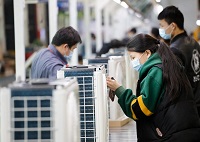 Already, for the last few years, supply chain was shifting away from China to countries like Vietnam, Bangladesh, India, and Mexico. However, the outbreak of COVID-19 has accelerated this process despite China being on a road to recovery.
Already, for the last few years, supply chain was shifting away from China to countries like Vietnam, Bangladesh, India, and Mexico. However, the outbreak of COVID-19 has accelerated this process despite China being on a road to recovery.
Though China has the best infrastructure in the world to support large manufacturing businesses, the current crisis along with the end of quota system, development of new capabilities and evolving sustainability issues, is forcing retailers to carefully review all factors before moving from an established, trusted entity.
Exports from China on the decline
A survey by CGS (Computer Generated Solutions) reveals China, being one of the largest producers of soft goods, exports around, 30.75 per cent to the US. However, for the 12-months ending in October 2019, the country’s exports declined by 5.6 per cent to $22.13 billion. However, it was still expected that China would produce a major share of goods bound for the US. Now, the outbreak has crushed this hope. Though the full effect of Coronavirus is yet to be measured, reports suggest productivity has not yet reached anywhere near capacity. Covid-19 has abated to a point where some stores are being compelled to reopen at new locations.
Though China was traditionally known to have cheap labor, it is no longer the case. Now, it has become very efficient. In fact shipping time from Shanghai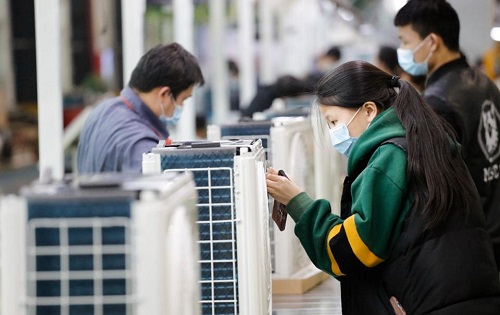 to Los Angeles is 23 to 31 days; shorter than from any other country except Mexico.
to Los Angeles is 23 to 31 days; shorter than from any other country except Mexico.
Bangladesh revamps logistics, increases wages
The second largest garment exporter after China, Bangladesh produces apparels for some of the biggest retailers in the world. Its garment manufacturing activity accounts for 80 per cent of the country’s export earnings. For the period ended October 2019, the country shipped apparels worth $5.1 billion to the United States, an increase of 10 per cent from previous year. Footwear imports increased a whopping 32.6 per cent during the same period. The country has revamped its logistics facilities, and increased wages in 2019 besides putting most garment workers under one digital wage system.
Growing trade deficits hampers Vietnam’s reputation
Vietnam’s apparels exports to the United States in the period ended October 2019 increased 10.9 per cent. Caused by an increase in wages the value of its exports also increased about $11.7 billion. The CGS report reveals the country received an influx of investment during this period and currently enjoys the benefits of the Comprehensive and Progressive Agreement for Trans-Pacific Partnership, an agreement which gives partner nations duty-free access to Vietnam made goods. Since the country is closer to China in location, it is easy for companies to transfer production there. Many Chinese apparel companies have built their factories, mills, and wholesale supply chains in the country. This enhances Vietnam’s reputation as a production site. However, its growing trade deficit may elicit tariffs.
India building vertical resources to enhance exports
India’s exports to the US during the period ended October 2019 increased by 6.9 per cent to $3.6 billion. Of this footwear exports increased 5.4 per cent. To improve its exports further, India is building its vertical resources. It has so far approved 74 textile parks, 18 these are operational, and 32 are under development. The government is inspecting thousands of factories. In Spring 2019, the United States changed India’s designation as a beneficiary developing country under the Generalized System of Preference program.
Uncertainty, labor issues impact Mexico exports
Apparel exports from Mexico to the US declined 5.6 per cent in the first 10 months of 2019. However, its exports of denim products increased by 2.9 per cent to $690.4 million. Though a new United States, Mexico, Canada Agreement was signed it is likely to boost exports from Mexico, the uncertainty over implementation of the agreement has forced companies to balance risk and opportunities. The country also faces labor rights issues which could be disruptive. In addition, the government raised minimum wage by 20 per cent on January 2020. Its footwear exports fell by 13.2 per cent in the first 10 months of 2019.
While companies have diverted their shifting from China, they are yet to decide on the destination for sourcing. Retailers are also seeking options outside China to produce apparel. However, other countries lack the operational sophistication that China has.
China’s recovery from Coronavirus is likely to be slow and painful. However, US retailers cannot wait. They have to place orders for Christmas 2020. For this, they need to divert their production to nearby countries. COVID-19 has added uncertainty to their near-term plans and urgency to accelerate their shift in production.
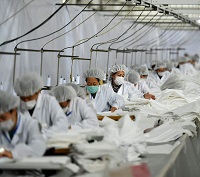 With the global pandemic, US textile and apparel industry is stepping up in a big way to answer the call for much-needed medical equipment. Parkdale Inc, a large yarn spinner in Gastonia, N.C., has collaborated with Hanesbrands, Fruit of the Loom, American Giant, Los Angeles Apparel, AST Sportswear, Sanmar, America Knits, Beverly Knits and Riegel Linen to set up a manufacturing supply chain and begin ramping up production of masks.
With the global pandemic, US textile and apparel industry is stepping up in a big way to answer the call for much-needed medical equipment. Parkdale Inc, a large yarn spinner in Gastonia, N.C., has collaborated with Hanesbrands, Fruit of the Loom, American Giant, Los Angeles Apparel, AST Sportswear, Sanmar, America Knits, Beverly Knits and Riegel Linen to set up a manufacturing supply chain and begin ramping up production of masks.
The companies have already begun production and will make the first deliveries by mid-week. They will create a high output of facemasks. Once fully ramped up in four to five weeks, the companies expect to produce up to 10 million facemasks per week in the US and Central America.
The industry is also reaching out to cut-and-sew operations across the spectrum to help fill the need created by the health crisis. While some companies are already producing medical-related textiles, others are now trying to ramp up their operations to fill the need. Even hospitals are working directly with these companies, while others are tapping into their own supply chains.
Parkdale was able to get involved in the coalition and has converted its factory in Middlesex, N.C., from T-shirt production to medical mask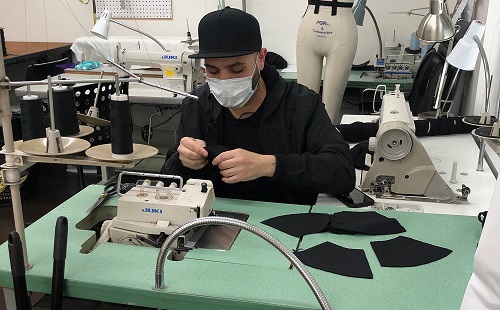 manufacturing. Production should start Tuesday, according to Winthrop, as fabric arrives from Miami, while special machinery he has purchased is in place. Similarly, Beverly Knits Inc., which is involved in the effort led by Hanes and Parkdale, is ramping up production to provide face masks by retooling its production lines. The company is coordinating the production of up to 1.5 million masks produced domestically per week.
manufacturing. Production should start Tuesday, according to Winthrop, as fabric arrives from Miami, while special machinery he has purchased is in place. Similarly, Beverly Knits Inc., which is involved in the effort led by Hanes and Parkdale, is ramping up production to provide face masks by retooling its production lines. The company is coordinating the production of up to 1.5 million masks produced domestically per week.
The Americas Apparel Production Network (AAPN) has set up a special message board to expand the number of companies wanting to participate in the effort. Its members have shared specs and patters, along with resources and company contacts to aid the movement.
Across the spectrum
Many companies are also pitching in on their own to ease the burden during the COVID-19 crisis. For instance, Milliken & Company has increased domestic production of BioSmart fabric. The company has prioritised the production of advanced material in their supply chain to better protect healthcare professionals regularly exposed to bacteria and viruses.
Similarly, BioSmart integrates anti-microbial protection into the most common medical products like scrubs, lab coats and privacy curtains. The patented, bleach-activated technology harnesses the proven power of chlorine bleach to kill 99.9 percent of bacteria and viruses. Manufactured in the US, BioSmart fabric is available through Prime Medical and is equipped with advanced molecular engineering that binds chlorine to fibers to turn otherwise passive textiles into one more layer of active defense against inadvertent microbial exposure, contamination and infection.
In response to the national shortage of surgical-grade face masks, designer Michael Costello has designed a cotton-nylon blend protective mask with a 70 to 74 per cent air filtration effectiveness rate, in comparison to the 97 per cent effectiveness of surgical face masks. The designer reached out to the Centers for Disease Control and Prevention to identify best fabrics for masks, then partnered with a manufacturer to activate specialised machinery that will help his team produce 20,000 protective face masks, which the designer plans to donate to medical professionals, first responders and hospitals in Los Angeles.
Kitsbow, a premium bike apparel brand based in Old Fort, NC, diverted its apparel production to making face shields for first responders, as well as reusable face masks. The company obtained the design of a face shield from the University of Wisconsin-Madison Makerspace. It currently sells the masks at cost to local first responders and medical staff, but plans to distribute internationally as it makes more.
Made in America
It may be early yet to talk about whether the crisis will result in a more companies wanting to manufacture in the US to reduce risks in supply chain but more than half manufacturers are likely to likely to bring production and sourcing back to North America. Many North American companies are forging ahead and seeking solutions, including turning toward domestic sources of supply, a trend which will help shape the next wave of manufacturing.
A new report by retail data analytics firm Edited reveals the average advertised full price of men’s jeans has climbed considerably since 2018. The full price of men’s jeans, as of March 17, 2020, is up 46 percent to $211.60. This growth reflects how the male consumer is evolving into a key fashion consumer. Meanwhile, the price of women’s jeans grew 16 percent to $170—demonstrating it’s the more competitive market.
Though $200-plus price tags are a hallmark of the premium denim sector, Edited’s data shows a shift away from the inexpensive fast-fashion styles that have plagued the denim industry for years. Even Gap is inching closer to the $100 mark, Edited noted, with 55 percent of its U.S. women’s jeans being advertised full price for $70-$80.
Prices for women’s jeans by mass market brands like Uniqlo and Zara in the US, however, continue to hover around $30-$40. The rising price of jeans falls in line with the growing number of sustainable jeans hitting the market, and the stories brands are creating around their eco products. In fact, Edited’s data shows that the amount of new sustainable denim arrivals online has nearly doubled from Q1 2008 to Q1 2020.
These garments are primarily made with recycled or repurposed fabrics and alternative fibers like organic cotton, Repreve and hemp, and are coupled with consumer-oriented messaging on how to care for the jeans.
The Waste & Resources Action Programme (WRAP), a UK-registered charity organisation, has offered a £1.5 million in grants to support projects that provide innovative ways for textile waste to be recycled or re-used, keeping it out of landfill or incineration so that it remains a valuable resource. The money is part of the department for environment, food and rural affairs’ £18 million Resource Action Fund, set up to support key priority policy areas.
WRAP works with governments, businesses and citizens to create a world in which we source and use resources sustainably. The grants, of between £20,000 and £170,000, are available to organisations of any size, both commercial and not-for-profit. The money is for capital expenditure only; either for equipment or technologies (excluding software and apps) that enable recycling or re-use of clothing or linen waste textiles.
Each project will require match funding: 10 per cent from not-for-profit and 50 per cent from commercial organisations. Successful projects will need to demonstrate ‘innovation beyond normal practice’ and will be assessed against a number of criteria, WRAP said in a press release.
Increased textiles collection and reprocessing is required in the United Kingdom to help deliver the Resource and Waste Strategy (R&WS) and the Circular Economy Package (CEP) objectives. Existing markets for recycled textiles are small scale and traditional, with little innovation or growth potential.
To meet the requirement for separate collections of textiles by 2025, new processes and markets need to be found, to avoid separately collected items simply being discarded. In addition, feedback from the textiles recycling sector suggests that export markets may diminish over time as other countries increase their exports of used textiles.
The aim of this grant fund is to address the need for increased capacity, sorting, handling, and reprocessing textiles from municipal sources.












